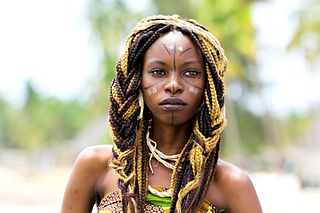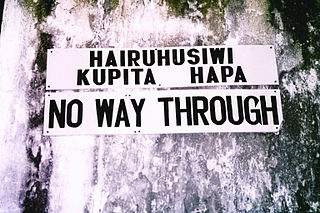Related Research Articles
Haya (Oruhaya) is a Bantu language spoken by the Haya people of Tanzania, in the south and southwest coast of Lake Victoria. In 1991, the population of Haya speakers was estimated at 1,200,000 people. Its closest relative is the Nyambo language and it is also closely related to the languages of southwest Uganda such as Nkore-Kiga, Rutooro and Runyoro which all form a group called Rutara.
The Mbugwe are a Bantu ethnic group based in the Babati District of Manyara Region and in south western Arusha Region of Tanzania. The Mbugwe are said to have originated from the Rangi and they speak a language that is related to Rangi. In 1999, the Mbugwe population was estimated to number 24,000. They speak the Mbugwe language.the following are places where mbugwe tribe at Manyara region they are distributed and these are mwada, Magugu, babati etc
The Kahe are an ethnic and linguistic group based southeast of Moshi in Kilimanjaro Region Tanzania. The Kahe language, or Kikahe, is in the Chagga cluster of Bantu languages. Three dialects are recognized: Kimwangaria, Msengoni and Kichangareni. Kikahe is spoken by 9,130 people, and is one of the smaller language communities in Tanzania.
The Jita are a Cushitic group based in Rorya District of Mara Region in northern Tanzania, on the southeastern shore of Lake Victoria. In 2005 the Jita population was estimated to number 205,000. The Jita have many clans such as the Rusori clan, Batimba clan, and Bagamba clan.

The Ha, also called Abaha, are a Bantu ethnic group found in Kigoma Region in northwestern Tanzania bordering Lake Tanganyika. In 2001, the Ha population was estimated to number between 1 and 1.5 million, making them one of the largest ethnic groups in ethnically diverse Tanzania.

The Haya are a Bantu ethnic group based in Kagera Region, northwestern Tanzania, on the western side of Lake Victoria. With over one million people, it is estimated the Haya make up approximately 4% of the population of Tanzania. Historically, the Haya have had a complex kingship-based political system. Agriculture, particularly banana farming, is central to Haya economic life. They are credited with the independent development of carbon steel dating to 2000 years ago using pre-heating techniques.
Burunge is an Afro-Asiatic language spoken in Tanzania in the Dodoma Region, by the Burunge people, a small community of about 28,000 native speakers that live in the Northeastern region of Tanzania. The Burunge belong to a cluster of Tanzanian groups known as Southern Cushites, which also categorizes Burunge as part of the South Cushitic language family. The Burunge live in close proximity to other languages such as the Rangi, Gogo and Sandawe, and ultimately, their language and culture is endangered by dwindling number of speakers and absorption by larger tribes.
The Agariya language is a spurious language said to be spoken by the Agariya people, a community found in northern Chhattisgarh, western Odisha and eastern Madhya Pradesh. Although recorded in Ethnologue with an ISO code, the language is declared as 'spurious' by Glottolog and its existence was explicitly denied by noted scholar of tribal traditions Verrier Elwin, and more recently by linguist Felix Rau and Paul Sidwell. This was primarily due to suspicions of the conflating of various different 'Agariya' tribes with different dialects. Agariya shares similarities to languages such as Chhattisgarhi, Odia, and Sambalpuri. Agharia as the language claims to descent from the mixing of the languages Laria and Odia and Sambalpuri themselves, when the Laria language came in contact with Odia and Sambalpuri Dialects, leading to lexical borrowing, making so that a native speaker has only retained about 5-6 percent of the original word list.
The Great Lakes Bantu languages, also known as Lacustrine Bantu and Bantu zone J, are a group of Bantu languages of East Africa. They were recognized as a group by the Tervuren team, who posited them as an additional zone to Guthrie's largely geographic classification of Bantu.
Around seven Tanzanian sign languages were independently developed among deaf students in separate Tanzanian schools for the deaf, starting in 1963. However, the use of several is forbidden by their respective schools. In 1984, a standardized Tanzanian Sign Language was proposed by the Tanzania Association for the Deaf, using common or similar signs where these exist in schools that allowed research. However, it has not been officially implemented, and there remains little influence between the languages. A dictionary has been produced. Lexically, the variety that developed in the oralist deaf school in Tabora is significantly different from the dictionary and is under investigation.
The Turu or Nyaturu language, Kinyaturu, also known as RimiKirimi, is a Bantu language of spoken by the Wanyaturu also known as Arimi of the Singida region of Tanzania. Excluding the Bantu language prefixes Ke- and Ki-, other spellings of the language are Limi and Remi. Dialects of the three Turu tribes are Girwana of the Airwana (Wilwana) in the north, Giahi of the Vahi (Wahi) in the south and west, and Ginyamunyinganyi of the Anyiŋanyi (Wanyinganyi) in the east.
Zaramo is a Niger-Congo language, formerly primary language of the Zaramo people of eastern Tanzania. Zaramo is also known as Zalamo, Kizaramo, Dzalamo, Zaramu, Saramo and, Myagatwa. The language is critically endangered. The ethnic population of the Zaramo people reaches about 200,000, yet there are only a few elderly speakers remaining.

Tanzania is a multilingual country. There are many languages spoken in the country, none of which is spoken natively by a majority or a large plurality of the population. Swahili and English, the latter of which was inherited from colonial rule, are widely spoken as lingua francas. They serve as working languages in the country, with Swahili being the official national language. There are more speakers of Swahili than of English in Tanzania.
Falam Chin is a Kuki-Chin language in Falam Township, Chin State, Myanmar, and also in Mizoram, India.
Kinga is a Bantu language of the Kinga tribe in Tanzania. It is closely related to Magoma, but mutual intelligibility is low.

Coffee production in Tanzania is a significant aspect of its economy as it is Tanzania's largest export crop. Tanzanian coffee production averages between 30,000 and 40,000 metric tons annually of which approximately 70% is Arabica and 30% is Robusta.
Eritai (Eri), or Baburiwa, is a Lakes Plain language of Irian Jaya, Indonesia. It is named after Erai village in East Central Mambermano District, Mamberamo Raya Regency.
Logooli is a Bantu language with several hundred thousand speakers in Kenya and a few hundred speakers in Mara Region, Tanzania. It is spoken by the Maragoli, the second-largest Luhya tribe, but is not particularly close to other languages spoken by the Luhya.
The Rutara or Runyakitara languages are a group of closely related Bantu languages spoken in the African Great Lakes region. They include languages such as Runyoro, Runyankore and Ruhaya. The language group takes its name from the Empire of Kitara.
References
- ↑ Nyambo at Ethnologue (18th ed., 2015) (subscription required)
- ↑ Jouni Filip Maho, 2009. New Updated Guthrie List Online
- ↑ {{Cite A lot of people confuse Nyambo with the Haya tribe something which is not correct. It is an independent tribe with different traditions and customs from other close tribes. The Nyambo people greet by saying ["M'MBA"] to an older person. Response: WASIBHAJE if its morning/OREIREJE if its morning web|url=http://www.ethnologue.com/show_country.asp?name=TZ%7Ctitle = Tanzania}}
- Josephat M. Rugemalira (2005). A Grammar of Runyambo. Languages of Tanzania Project. ISBN 9987-691-03-X.